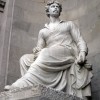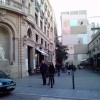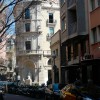Marià Fortuny
Carrer Pintor Fortuny with Xuclà
Sculptor: Miquel Oslé, signed
Materials: White marble on pedestal made of stone from Montjuïc
Inauguration: June 20, 1942
The first idea of a monument to Mariano Fortuny (Reus, 1838 - Rome, 1874) was Ignasi Iglesias, as a municipal councilor in 1911. an executive committee was formed in February 1912, but the design of monument He was unsuccessful. In 1918 he rekindled enthusiasm for citizen Fortuny, hand art critic Joaquín Deer and Artistic Circle. a committee for Fortuny who promoted an impressive campaign with lectures, articles, exhibitions, raffles and collections of donations was formed. With the money raised a statue of the painter Miquel and the sculptors Oslé Llucià was commissioned and then asked the City Council to offer a national monument place to place. At first it was thought in the gardens there in front of the Palau de la Virreina or in the Royal Square.
Meanwhile, he broke the Bank of Barcelona, where they had deposited the money in favor of Fortuny committee, and the brothers met Oslé commissioned halfway between hands that did not know when or how would charge. In 1922 they had virtually completed the sculpture, but it got stuck until 1934, when the sixtieth anniversary of the painter's death was fulfilled.
This time the initiative was taken by the City Council. Christmas 1932 had burned warehouses El Siglo, and the demolition of the building was allowed to open the Pintor Fortuny to the Rambla. It was thought that there was no other more suitable place for the monument that place bearing the name of the artist. But the street was narrow and did not allow the monument was placed in the middle, so had to opt for the system niche. The fact is that the Oslé brothers, to start making the statue, had thought of a monument to be placed in a square so it would look everywhere, and were worn by a rear that, according to experts, is the most interesting statue, the folds of drapery and engravings on the stone where the painter is sitting. The solution of the hornacina prevent see this behind, but failed to find any better solution and the City Council signed an agreement with the Banco Hispano-Colonial under which it undertook to make the niche in the wall of the building facing the Xuclà and Pintor Fortuny streets. In 1936, the facade of the building facing the street piece new opening was gone and the niche was made, but the Civil War prevented was reached to put the statue and the official inauguration of the monument was made.
On June 15, 1939, Carles Fages de Climent published in La Vanguardia Spanish one calling celebrate article, albeit belatedly, the centenary of the birth of Mariano Fortuny, which he said had taken place on June 8, 1938, date documentary very uncertain. Fages de Climent remembered the statue made by Oslé brothers before the war and space reserved on the street bearing the name of the painter.
The article Fages de Climent Barcelona City Council encouraged the installation of the monument. There were three facts that made it possible: the idea of the monument had been driven by the local council Bienni Negre (right-wing government during the Second Republic) and specifically by Councilman Ramon Coll and Rodés; the authors were the Oslé brothers, whom the captain-general had ordered the memorial of Santa Elena moat in Montjuïc Castle; and the fact that Fortuny was one of the few Catalan artists well regarded by the new regime. The official inauguration of the monument, already placed, was made on June 20, 1942.
-
Raval - C. del Pintor Fortuny, 3
-
Metro
L1 L3 CATALUNYA L3 LICEU








